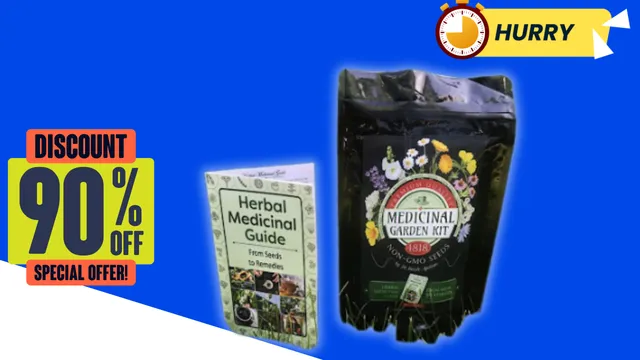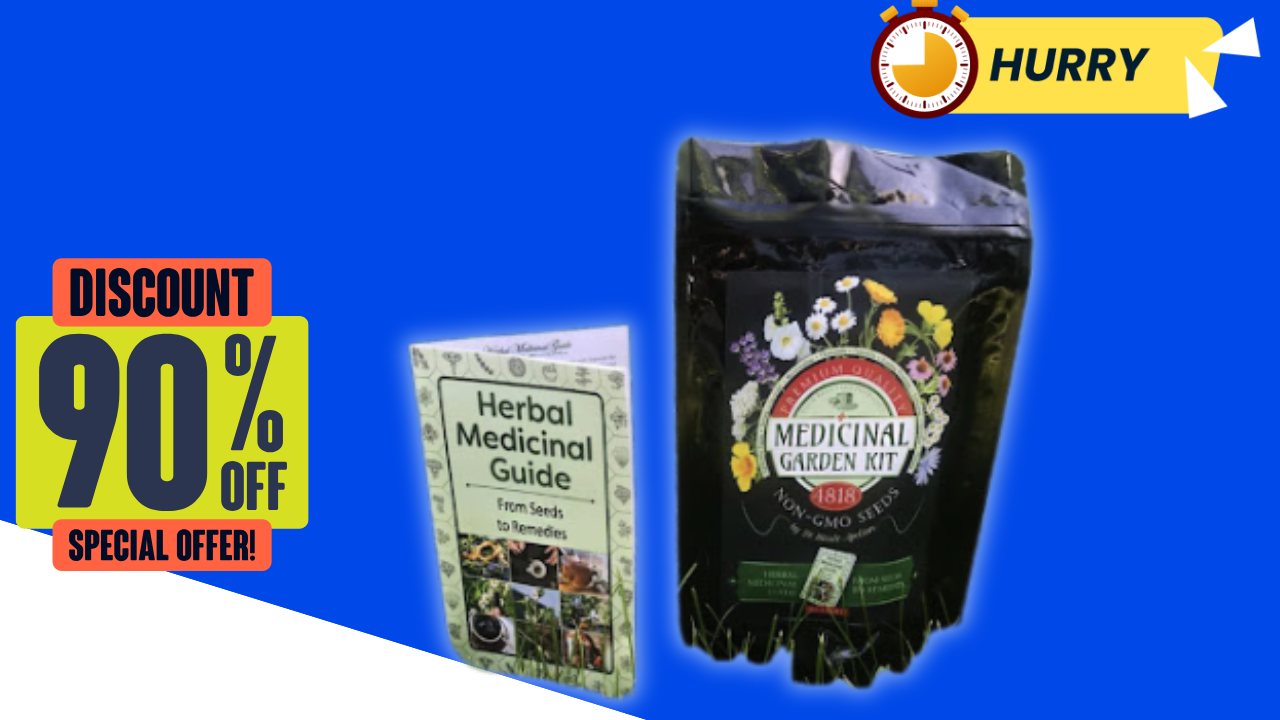



What Not to Do in Medicinal Garden Kit Guide Review 2025
⭐ Ratings: 5/5⭐⭐⭐⭐⭐ (4.5K)
📝 Reviews – 88,000 reviews
💵 Price – $59
📦 Free Shipping on Orders Over $50
🌱 100% Organic, Non-GMO Seeds
Recommendation: Highly Recommended
Guarantee: 365-Day Money-Back Guarantee

There you are, standing in your garden with the Medicinal Garden Kit in your hands. You’re excited, right? This is it—your journey to self-sufficiency, healthy herbs, and the world of natural remedies is about to begin. But then… wait. What if you’re about to make all the classic mistakes everyone else makes?
It’s easy to assume that gardening, especially with a kit as amazing as the Medicinal Garden Kit Guide, is a straightforward process. You follow the steps, water your plants, and—voila! Right? Well, not quite. It turns out that many well-meaning gardeners unknowingly dig themselves into a hole—figuratively and literally—by making the same mistakes over and over again.
And let’s be real: just following the instructions won’t always get you where you want to go. Sure, you may grow some herbs, but to unlock your garden's true potential, it’s about avoiding those little things that can easily derail your efforts. We all know that good habits are essential, but let’s be honest—sometimes, it’s the bad ones we don’t notice that are the most damaging. So let’s dig in—no pun intended—and identify the mistakes so you can avoid them like a pro.
Wrong Way: Overwatering – The Silent Plant Killer
Ah, water. That beautiful, life-sustaining liquid. We love it, right? Plants must love it too—more water, more growth, more beauty. Sounds logical enough, doesn’t it? But here’s the ugly truth: too much of a good thing isn’t always good. Overwatering is one of the easiest ways to sabotage your plants before they even have a chance to grow.
Why is this a mistake? The roots of your plants need air, and when they’re submerged in water for too long, they suffocate. It’s like putting someone in a pool and asking them to breathe—they’ll drown. Root rot is a slow, insidious killer that most gardeners don’t notice until it’s too late. It’s a simple mistake: water a little too much, and suddenly, you’re left with yellow leaves, wilted stems, and a soggy mess of regret.
Smarter alternative: Watering isn’t a guessing game. It’s a little like checking your fridge for leftovers—you have to know what’s inside. Stick your finger into the soil—does it feel dry? If so, water. If not, take a step back. It’s about understanding your plants’ needs. Different herbs need different amounts—for example, lavender is a fan of dry soil, but mint might need a little more attention. So, trust your plants—they will tell you what they need, if you just listen.
Real-life example: Sarah, who lives just outside Brighton, was loving her chamomile, but every morning, she’d water it like she was watering a garden full of thirsty desert plants. Her chamomile started wilting, and she didn’t know why. After some research, she found out that chamomile doesn’t need constant watering—and after backing off a bit, her plants bounced back. Simple, right? The power of less water made her garden thrive.
Impact: By watering only when needed, you’re setting your plants up for strong, healthy roots, faster growth, and the kind of vibrancy that makes your garden the envy of the neighborhood. Plus, you’ll save time and become more attuned to your plants’ true needs.
Wrong Way: Planting Without Considering Light Needs – Sun Isn’t Always the Answer
Here’s one for the books: you’ve probably seen a meme or two about how plants love sunlight, right? So, the natural reaction is to think, “Throw everything in the sun and let them grow.” Right? Well, not so fast. Sunlight is great, but it’s not a one-size-fits-all solution.
Why is this a mistake? Some herbs love the sun, but others can’t handle it. Let’s break it down. Thyme, rosemary, and basil want full sun—they’re basically sun worshipers. But then you have your mint and chamomile, which are more like the introverts of the garden world—they prefer partial shade or some cool relief. If you force your shade-loving plants into full sunlight, they’ll be like a party-goer who just wants to leave the loud club, and soon enough, they’ll be wilted, stressed, and not producing the goods.
Smarter alternative: Research your herbs’ light requirements and give them the best environment possible. You don’t need to turn your whole garden into a sun-baked desert—find spots that match each plant’s needs. Think about the sun patterns in your garden throughout the day and give your plants what they’re naturally suited for. You can even rotate plants around to give them the proper light exposure if you’re limited on space.
Real-life example: When Ben from London planted his mint in a sunny corner of his garden, it didn’t take long before the plant started looking limp and sad. He’d seen others growing mint in the sun and assumed it would work, but after some digging, he realized mint thrives in partial shade. After moving it to a cooler, shaded area, it perked up within days—mint heaven restored.
Impact: Understanding the sunlight needs of your plants allows you to place them in the ideal spots, helping them thrive. A little shade goes a long way for some plants, and giving them what they need will result in healthier, happier plants that require less attention.
Wrong Way: Cramming Too Many Plants Into One Space – Space Matters
Here’s a mistake that many gardeners don’t realize until it’s too late: the whole “if I plant more, I’ll get more” mindset. The truth? More plants don’t always mean more success. Overcrowding your garden is like trying to jam too many people into a small room—it just doesn’t work.
Why is this a mistake? When you crowd your plants, they start competing for resources—light, water, space, air. Instead of helping each other grow, they end up stressing each other out. The result? Stunted growth, weakened plants, and a greater chance of disease. Plants need their space to breathe, stretch, and grow strong. Overcrowding them causes competition, and like any bad relationship, it just doesn’t work.
Smarter alternative: Give your plants room to grow. Follow the recommended spacing guidelines for each herb. This doesn’t mean you need to build a garden the size of a football field, but it does mean ensuring each plant has its own space to thrive. You’ll notice that plants will grow taller, healthier, and more vibrant if they aren’t cramped together.
Real-life example: Katie was excited to fill her garden with herbs—rosemary, mint, and lavender all crammed into one bed. A few weeks later, the mint started to outgrow everything else, and the rosemary didn’t grow at all. After giving each plant the space it needed, she saw remarkable improvement—her garden became healthier, and the plants had enough room to thrive without competition.
Impact: A little space goes a long way. With proper spacing, your plants will grow stronger, and you’ll get better yields with less effort. Trust me—space is the secret.
Wrong Way: Using Cheap Tools – The Struggle Is Real
Let’s face it: cheap tools might seem like a bargain, but they’re really just a pain in the neck. Cheap, flimsy gardening tools will make the whole process more tedious than it needs to be. A dull pair of pruners? You’ll struggle to make clean cuts. A flimsy watering can that spills everywhere? Wasteful. You might save money upfront, but in the long run, you’ll just be working harder for worse results.
Why is this a mistake? Poor-quality tools make everything more difficult, and when you’re working with plants that need your care and attention, you want the right tools for the job. It’s not just about getting it done—it’s about getting it done well. Plus, when your tools break, you end up spending more time fixing than actually gardening.
Smarter alternative: Invest in quality tools. You don’t need the most expensive set on the market, but something that’s sturdy and designed for the job will save you time, effort, and money in the long run. The difference is night and day—from a sharp pair of pruners that make clean cuts to a watering can that actually delivers water evenly.
Real-life example: Claire in Cardiff was frustrated with her cheap watering can. It leaked constantly, and she was wasting water on her plants. After splurging on a well-made watering can, her watering routine became easier. The plants got the water they needed, without the mess, and she finally felt like she was using her time wisely.
Impact: The right tools make gardening more enjoyable and effective. When your tools work as hard as you do, the results are immediate.
Time to Rethink Your Garden Strategy
So, here’s the bottom line: the secret to a successful medicinal garden isn’t just about following every single instruction. It’s about avoiding the mistakes that could hold you back. From overwatering to choosing the wrong tools, the small changes you make can have a big impact on your garden's success.
It’s time to rethink your approach. Stop making these common mistakes, and start planting the seeds for a stronger, healthier, and more vibrant garden. After all, your Medicinal Garden Kit Guide is packed with potential—it’s up to you to unlock it.
Start now.
Related Hashtags :
#MedicinalGardenKit #MedicinalGardenKitReview #MedicinalGardenKitReviews2025 #MedicinalGardenKitAppReview2025 #MedicinalGardenKitBonus #MedicinalGardenKitProduct #MedicinalGardenKitPrice #MedicinalGardenKitOffers #MedicinalGardenKitBonuses #MedicinalGardenKitBuy #MedicinalGardenKitWebsite #MedicinalGardenKitSite #MedicinalGardenKitApp #MedicinalGardenKitHonestReviews #MedicinalGardenKitLatestReviews #MedicinalGardenKitUsersExperience #MedicinalGardenKitUsersReview #MedicinalGardenKitDemo #MedicinalGardenKitTutorial #MedicinalGardenKitPurchaseOnline #MedicinalGardenKitBuyit #HerbalRemedies #GrowYourOwnMedicine #NaturalHealing #HomeHerbalGarden #MedicinalPlants
